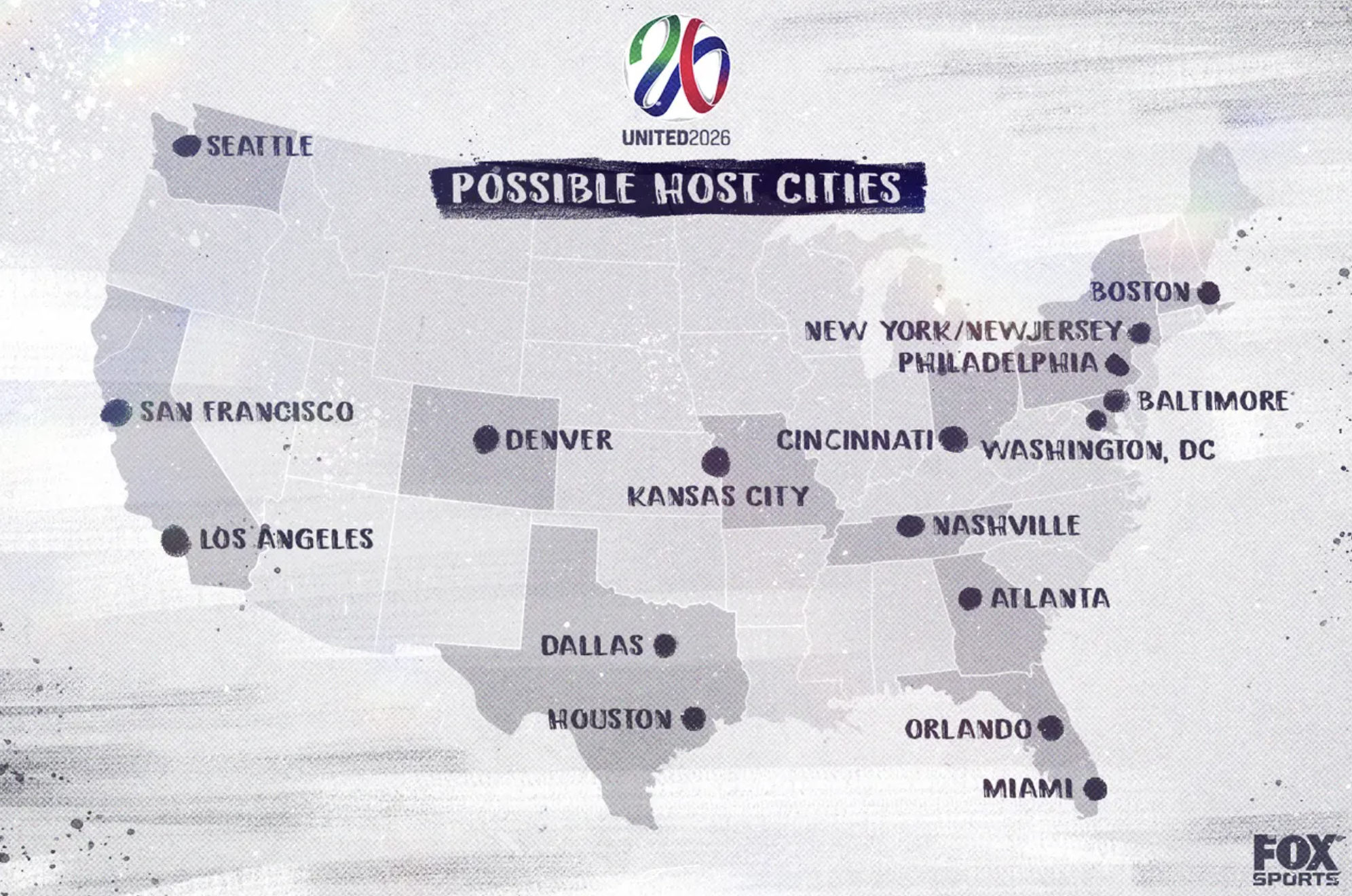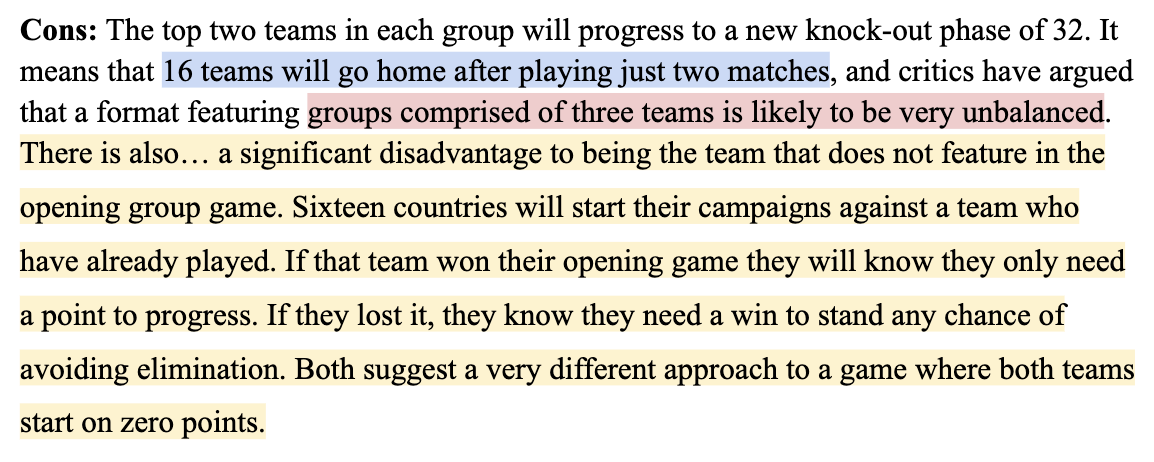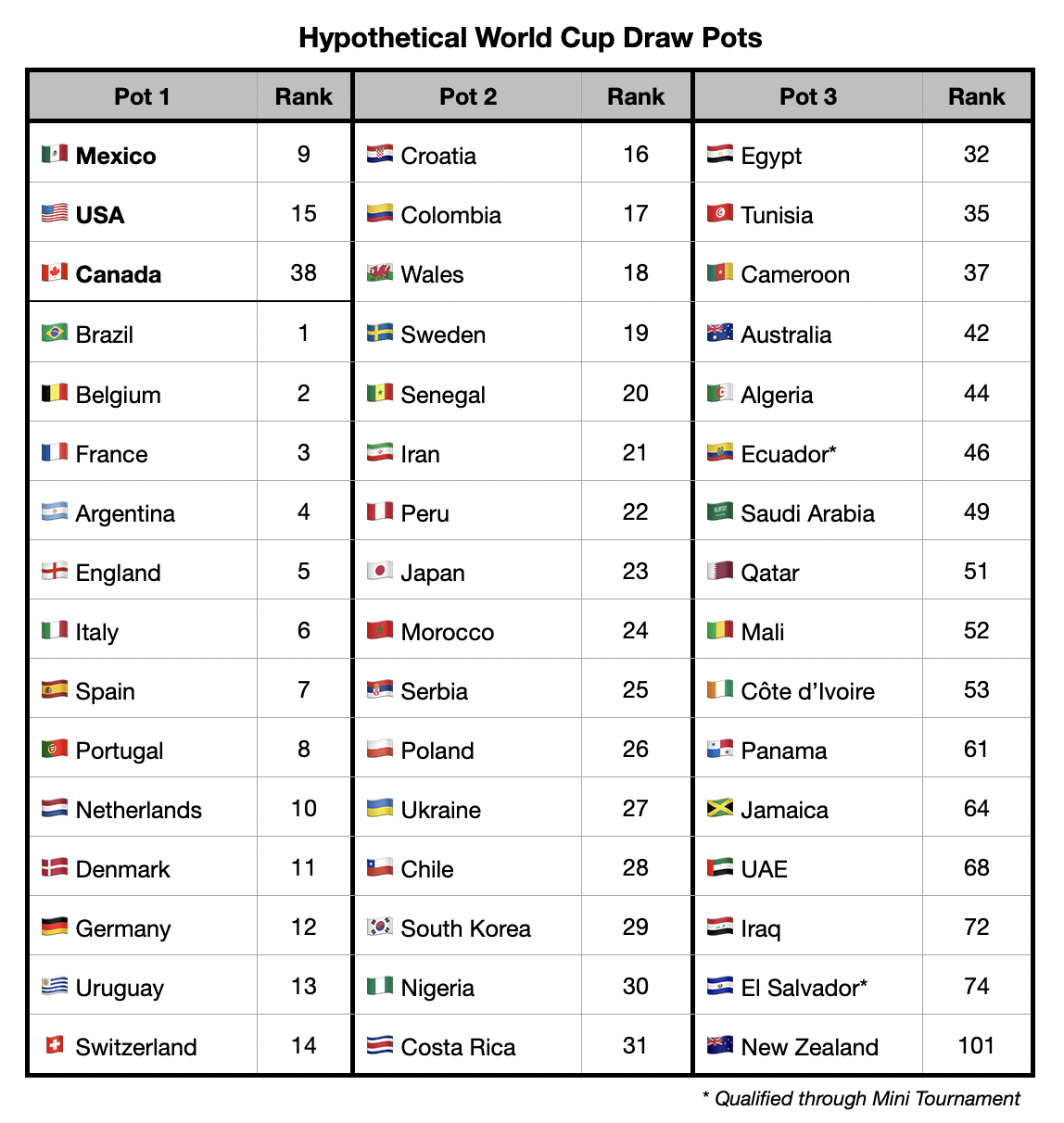Optimizing the 2026 World Cup Format
Published on May 4, 2022.
Tl;dr: I think that by using a “paired groups” approach, FIFA can dramatically improve the format of its first 48-team World Cup. This change would also allow FIFA to award additional games to more US host cities, making FIFA more money, giving more fans access to the World Cup, and helping grow the game across more regions of the country.
Introduction
The 2026 FIFA Men’s World Cup promises to be the greatest sporting spectacle of all time. What is already the biggest party in global sports is getting even bigger, with the tournament expanding from 32 to 48 teams for the first time. To accommodate the larger event, FIFA awarded joint hosting rights to the US, Mexico, and Canada, with the finalized host cities set to be announced this June.
The proposed format of the expanded tournament has been widely criticized for everything from skewing competitive advantage, reducing the guaranteed minimum number of games for each team, and even lending itself to collusion between teams in the final group stage match. In fact, the tournament’s Wikipedia page has a subsection devoted to criticism of the format. Let’s call this the 48-Team problem.
Is it too late to fix the format with host city decisions due so soon? Not at all – FIFA Vice President Victor Montagliani told The Times last month that the 2026 format could still be revamped specifically to address the possibility of collusion. Being close to an event hasn’t stopped FIFA from considering late changes before: just two weeks ago they added Vancouver to the mix of potential Canadian host cities, and just three years ago they were still probing the possibility of expanding this winter’s tournament in Qatar to 48 teams, a full eight years after hosting rights were awarded to the tiny nation for a 32-team event.
What’s more, by solving the 48-Team problem with a simple math concept, FIFA also has the opportunity to expand the number of host cities (and make tons more money in the process).
The 48-Team Problem
Here is the format FIFA has chosen to implement for its expanded 48-team World Cup:
16 groups of 3 teams
Round-robin for each group
Top 2 advance to Round of 32
Group A match-ups in a 3-team, round-robin format.
To put it gently, there are a lot of downsides to this format, but this Guardian piece does a good job of synthesizing its pros and cons. I’ve color coded them into distinct components that will define our criteria for an “ideal” tournament format.
All these pros focus on minimizing the additional burdens of the expanded event – on the organizers (green), on the global football calendar (purple), and on the players (orange). But even though the number of matches is listed first, the limiting conditions are really the tournament duration and player wellbeing, which require a delicate balance: you can shorten the tournament by cutting out rest between games, which would be unacceptable from a player health perspective, or you can reduce the load on players by adding more rest days, taking up the entire summer and wreaking havoc on football leagues around the world.
In my view, as long as a tournament format protects players’ health and fits within the existing World Cup calendar window, the limiting factor on number of matches is the host nation(s) ability to accommodate the additional matches without diluting the quality of the event. In the particular case of the US, where we have more high-quality candidate cities than host city slots available, this is not an issue at all.
This gives us our first three Ideal Tournament Criteria:
🗓 Fits within the existing World Cup calendar window
⛑ Protects players’ health
🏟 Adds no more extra matches than the host nation(s) can successfully accommodate
The first downside is very straightforward: some teams will fly halfway across the globe to participate in the World Cup and only play two matches, down from the current guarantee of at least three games per team.
The second requires a little unpacking. Half the group stage games involving seeded teams will be against relative minnows that wouldn’t have qualified under the current 32-team format, but the reason this matters is that it dilutes the entertainment value of the tournament. I believe fans would rather watch clashes between big teams, closely contested games, and drama that lasts all the way to the final whistle of the group stage than a bunch of lopsided scorelines. Reducing the entertainment value of the tournament would also hurt FIFA financially in the long term.
The third is a consequence of applying a round-robin format to an odd number of teams, which requires one team to sit out each matchday. These de facto “bye rounds” create an inherent physical disadvantage through uneven rest periods, and, coupled with the fact that two teams advance from each group, it opens the door to collusion between the two teams playing the final group stage match, since they will always go into that game knowing exactly what result each of them needs to qualify. Both the inherent disadvantages and the incentive to collude undermine the sporting integrity of the competition.
An ideal format would not have any of these cons, so let’s add three more Ideal Tournament Criteria:
3️⃣ Guarantees at least 3 games per team
📣 Prioritizes entertainment value
⚖️ Preserves sporting integrity
As a final note, I also think it’s important that decisions about which teams advance from the group stage are made on equal merits (i.e. apples to apples comparisons). That’s why I don’t like the “X best 3rd place teams advance” format in use at the Euros and the 2019 Women’s World Cup, which compares teams on their point totals after playing in different groups against completely different opponents. While it may be a necessary evil in some cases, an ideal tournament should avoid it, so I’ll add that as a final constraint in our Ideal Tournament Criteria:
🍎 Uses apples to apples comparisons
Here are our seven Ideal Tournament Criteria after putting everything together:
⚖️ Preserves competitive integrity
📣 Prioritizes entertainment value
3️⃣ Guarantees at least 3 games per team
🍎 Uses apples to apples comparisons
🗓 Fits within the existing World Cup calendar window
⛑ Protects players’ health
🏟 Adds no more extra matches than the host nation(s) can successfully accommodate
Paired Groups Format
To solve the downsides of using a round-robin format on groups with an odd number of teams, we could make the groups even-numbered, like the current standard of 4 teams per group in major international competitions. But the problem with 12 groups of 4 is that 12 is not a bracket-friendly friendly number (i.e. a power of 2), forcing us into “X best 3rd places” territory. In order to get a bracket-friendly number of groups with an even number of teams, we would need 8 groups of 6, lengthening the group stage significantly to 5 matchdays and increasing strain on players.
My suggestion is that FIFA should keep the 16 groups of 3, since 16 is already a bracket-friendly number. However, instead of using a round-robin within each group, they should create “Paired Groups” whose teams play their stage matches across groups.
Basically, instead of playing the teams in their own group, all the teams in a group would play against the teams in their Paired Group, then be ranked against their own group based on their performance.
This idea relies on the basic set theory concept of bijection, a fancy word for pairing elements of one set with elements of another set in a way that creates a one-to-one correspondence between them (see image for visualization).
In the World Cup case, we pair all the elements in one set (the teams in a group) with an equal number of elements in another set (the teams in the paired group), creating a one-to-one correspondence between elements (games) that eliminates “bye rounds” and comes with a whole bunch of other benefits.
Here’s a concrete example of how a Paired Group would work:
USA is pre-seeded as A1 in Group A, along with non-seeded teams A2 and A3.
Group A is “paired” with Group B, consisting of seeded team B1 and non-seeded teams B2 and B3.
Every group stage matchday is composed of a different bijection of Group A to Group B (see first graphic below).
Qualification to the Round of 32 is determined by a team’s standing in their own group table (see second graphic below).
Group A sends its teams to one side of the knockout bracket.
Group B sends its teams to the opposite side of the bracket as Group A to prevent teams that already played each other from meeting again until the final.
This solution is similar to one favored by this 2018 NYT op-ed, except that one eliminates the Round of 32, adds the possibility that some groups could have zero teams qualify to the knockouts, extends the tournament by a few days, and doesn’t provide an example of what the calendar or bracket pathway would look like.
Here’s how a Paired Groups approach meets our Ideal Tournament Criteria:
⚖️ Preserves competitive integrity: Since every team has an opponent every matchday, we’ve eliminated “bye rounds” and disparities in rest days. With simultaneous games on the final matchday, we also minimize the risk of collusion.
📣 Prioritizes entertainment value: Every Paired Group will feature a clash between seeded teams, bringing the number of top-16 games from zero under the round-robin format to eight under the Paired Group approach. The competitive balance will also be higher across the board, with every team playing a seeded team, an intermediate team, and a minnow in the group stage, giving everyone good opportunities to pick up points. As mentioned above, simultaneous “decision day” style matches on the final matchday can also increase drama. Finally, based on the new allocation of teams that each confederation will send to the World Cup, we’ll even get to see some intra-continental derbies and rivalries on the global stage.
3️⃣ Guarantees at least 3 games per team: Every team plays the three teams in their paired group. Easy!
🍎 Uses apples to apples comparisons: Every team in a group will have played the exact same set of opponents, so qualification to the knockout rounds is decided on equal footing.
🗓 Fits within the existing World Cup calendar window: The tournament can be played in 32 days, exactly the same length as Russia 2018 and Brazil 2014 (see calendar below).
⛑ Protects players’ health: Every team gets a minimum of 3 rest days between matches (except for the 3rd place match, which has been standard in the past but honestly should probably be scrapped altogether). Only the two finalists will play 8 competitive matches across 32 days, which is the same days-per-match ratio that awaits the finalists in Qatar 2022.
🏟 Adds no more extra matches than the host nation(s) can successfully accommodate: The Paired Groups format clocks in at 104 total matches, which represents a 24-match increase from the current plans of 80 matches. But given the high level of interest in hosting from so many US cities, this shouldn’t be an issue at all.
In fact, a format with more games could actually solve another 2026 headache for FIFA…
Bonus: The Host City Headache
Although the 2026 host countries were chosen back in 2018, we still don’t know which US cities will be the ones to host matches because the venue selection process has been plagued by pandemic-induced delays. One thing we do know is that only about 10 of the 17 US cities that bid to host games are expected to make the final cut, meaning some top-class venues and markets will miss out on hosting because there simply aren’t enough games to go around.
For FIFA, not having more games in high-quality host cities represents a massive opportunity cost for additional revenue, something they generally try to avoid; for US Soccer, it represents a missed once-in-a-generation opportunity to help grow the beautiful game in every corner of the country. And while some host city bids did have serious structural issues, basically every major American city has the necessary infrastructure (stadiums, airports, hotels, etc.) to host the World Cup and to do it really well.
Take Denver, for example, which Grant Wahl’s reporting says is unlikely to land games at the moment. Its metro area has a larger population (2.96 million) than the entire country of Qatar (2.88 million), its 76,000-seater NFL stadium opened this century, its airport ranks in the top 5 nationally for passenger traffic, it boasts more than 50,000 “first-class” hotel rooms, and its location in the Mountain timezone could be good for scheduling and breaking up trans-continental travel.
Denver would put on an awesome event, but my broader point is that so would Nashville, Orlando, Kansas City, and virtually every remaining bid city. If FIFA finds a way to put on more games to award to more cities, they’ll make boatloads more money.
How does the Paired Groups format fix this headache?
Right now, the plan is for an 80-game tournament with 60 games in the US and 10 games each in Mexico and Canada.
Assuming 10 US cities are selected, the average US hosting rate will be (60 games ÷ 10 cities) = 6 games per city.
The Paired Groups format gives us a 104-game tournament – a total increase of 24 games. Based on the hosting rate, that would open up additional host city slots for (24 games ÷ 6 games per city) = 4 cities. Great news for Boston and Seattle!
And in addition to spreading World Cup cheer to more regions of the US, how big is the financial upside of staging 24 more matches for FIFA? Without taking into account that more games present opportunities for more sponsor activations and more TV slots, the ticket revenue potential is already huge.
I think the estimates below are conservative; based on the relative wealth of the US population and the size of US stadiums and markets, I would be shocked if the median ticket prices and average game attendances at the 2026 World Cup aren’t higher than in Qatar and Russia, respectively. Even under these estimates, the additional ticketing revenue for FIFA could be as high as $180 million. (Remember, the World Cup’s financial model is that the hosts pay for everything and FIFA takes all the direct revenue.)
Conclusions
A Paired Groups approach for a 48-Team World Cup meets all of our Ideal Tournament Criteria and represents a huge improvement over FIFA’s planned format for 2026.
A Paired Groups approach also grants FIFA the opportunity to stage 24 additional, lucrative matches and award hosting rights to at least 4 more US cities.
While it may be difficult for other countries to emulate the 104-game format in future iterations of the tournament, I think it would encourage more joint hosting bids, which I see as a net positive because it spreads the joy and the costs of the World Cup among more countries.
Paired Groups Example:
Teams, Pots, Groups, Schedule, and Bracket
Below is a full accounting of what a Paired Groups format would look like in practice, from qualification all the way to the bracket path for every single team. Most of the graphics should be pretty straightforward with the help of a few notes:
Qualified Teams & Draw Pots: Both of these were determined by the number of qualifying slots from each confederation and the March 2022 FIFA Ranking (e.g. since UEFA has 16 slots, I chose the top 16 ranked UEFA teams). There’s also the new addition of an intercontinental mini tournament that will decide the final two slots; for these I chose the next highest-ranked teams from Concacaf and CONMEBOL just because the tournament takes place in the Americas.
Draw Constraints: There were three constraints in sorting the groups.
Regardless of their FIFA Ranking, all three hosts are pre-seeded into their exact positions, along with the top-ranked team in the world, to keep them in separate bracket quadrants and prevent them from meeting until the semifinals.
There is exactly one UEFA team in each group.
UEFA and CAF are the only confederations that can have two (but no more) teams in a Paired Group, since both confederations have more than 8 qualified teams.
Group Organization: I employed a couple different organizing mechanisms to better visualize the Paired Groups and bracket pathways.
16 Groups: A through O
8 Paired Groups: A/B, C/D, E/F, G/H, I/J, K/L, M/N, O/P
4 Colors: Blue (A through D), Green (E through H), Red (I through L), Yellow (M through O)
2 Rows: Top (A through H) and Bottom (I through O)
2 Shades: Dark (A, C, E, G, J, L, N, P) and Light (B, D, F, H, I, K, M, O)
Bracket Organization: After the Group Stage, which side of the bracket a team goes to is determined by their Shade, resulting in a Dark side of the bracket and a Light side of the bracket.
In the Rounds of 32 and 16, teams play against the same Color and Shade
In the Quarterfinals, teams play against the same Shade and Row
In the Semifinals, teams play against the same Shade and opposite Row
In the Final, teams finally play against the opposite Shade
This set-up keeps the hosts and the top-ranked team in the world apart until the Semifinals
It also keeps Group Stage opponents apart until the Final















